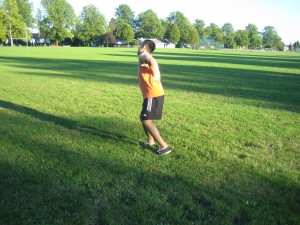Thigh pain a type of pain that affects the area stretching from the pelvis to the knee. The thighs gives structural support and enable movement which are made up of bones, tendons, muscles, ligaments, blood vessels and the nerves.
Muscles of the thigh provide movement while the tendons attach the thigh muscles to the bones of the pelvis and the lower leg. Nerves control the sensation and movement while the blood vessels provide proper circulation to and from the thigh. Any structures of the thigh can be injured, infected and end up with conditions that can cause pain.
Thigh pain can happen suddenly or gradually and can be dull and achy, throbbing, piercing or tingling. A person suffering from thigh pain will experience pin-like sensations, burning or prickling. In some cases, thigh pain is irritating and uncomfortable and there is difficulty in putting weight on the leg or while walking.

Thigh pain can be caused by several conditions. It can also be caused by a minor strain or contusion that can be treated using home remedies.
Symptoms of thigh pain
- Tingling sensation, pain and some abnormal sensations in the toes
- Joint pain and changes in gait such as limping
- Reduced range of motion
- Swelling
- Bruising, abrasion and laceration
- Muscle spasms
- Flu-like symptoms such as sore throat, fatigue, fever, cough and pain
- Burning and prickling feeling
Causes of thigh pain
- Groin pull or strain
- Fractures or dislocation usually involving the hip or thigh bone
- Laceration, abrasion or contusion on the thigh
- Meniscus tear which is a tear in the shock-absorbing cartilage of the bone
- Muscle cramp caused by dehydration or overuse
- Tendinitis which is irritation or irritation of the tendon by overuse or injury
Treatment and home remedies of thigh pain
- Rest the affected area, avoid activities such as running since can make the condition worse
- Apply an ice pack to the affected area. Ice causes vasoconstriction and minimizes inflammation and pain by reducing the flow of blood and lymph to the affected area. Apply an ice pack to the affected area at 20-minute intervals every day.
- When the inflammation has subsided, apply a warm compress since heat helps in promoting blood flow to the affected area.
- Take over-the-counter pain medications such as ibuprofen and naproxen in order to relieve thigh pain and inflammation.
- Perform stretching and strength-building exercises to help ease thigh pain. Stretching promotes mobility in the thigh and other joints as well as removal of scar tissue. Strength-building exercises such as leaning against the wall in a squat position can lessen pain in the thigh. Start the exercises slowly and gradually add some movements. Take note that both stretching and strength-building exercises encourage healing and promote circulation to different areas of the thigh.
